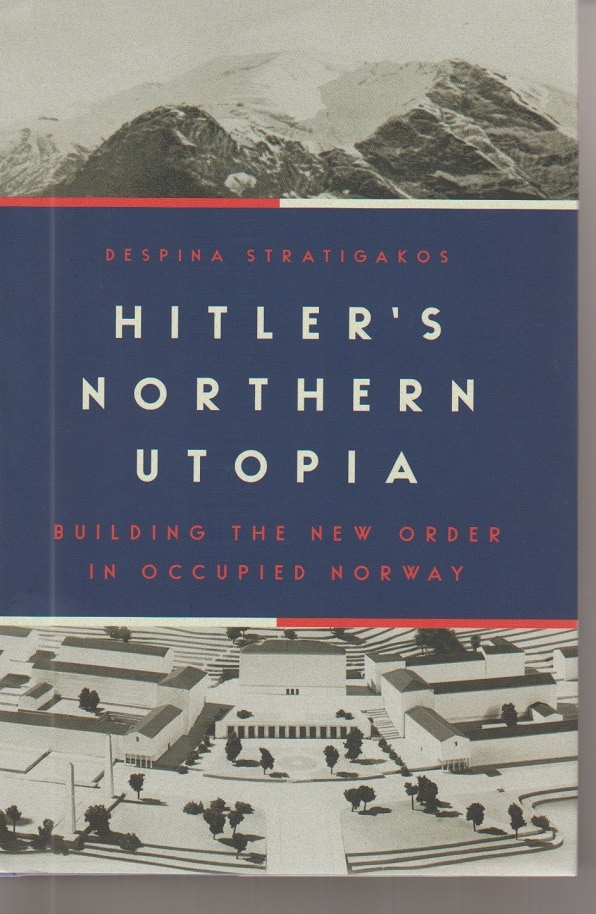In Hitler’s Northern Utopia (Princeton University Press, 313 pages, $29.95), historian Despina Stratigakos deeply mines World War II records and subsequent research to thoroughly detail for the first time the full extent of German plans for a post-war Norway.
The result is chilling.
In much of Europe, the goal of the occupying Germans was simply to clear the landscape for German settlement. As Stratigakos notes in her richly detailed and unsettling book:
In Eastern Europe, Hitler’s belief in the racial inferiority of the region’s Slavic and Jewish peoples and cultures justified a horrific tablua rasa approach — wiping the slate clean to create an all-new Germanic landscape, in which “subhumans,” and all physical traces of the “unclean” would be erased or pushed into the dark margins of the New Order.
By contrast, the Germans, from an historic perspective, looked up to the Norwegians as “racially superior” because of their Viking origins. These blue-eyed, blond-haired Aryan cousins were viewed as worthy of incorporation into the ultimately successful Third Reich — all, except for those who had lost touch with their Norse roots and were too “Americanized” or too Jewish or otherwise tainted.
The goal, Stratigakos writes, was to convince rather than compel the newly conquered cousins and to steer them “gently toward the glorious National Socialist future that they did not yet realize they wanted.”
This meant paying lip-service to Norwegian involvement in decisions about how the country was being run during the occupation. In addition, it meant introducing “novel forms and types of architecture in response to the native landscapes and traditions” in order to prepare Norwegians to embrace the National Socialist revolution of values and world view.
“Berlin’s sun”
Even so, this incorporation of the two populations was to be carried out in a manner that left the Germans in full control and relegated the Norwegians, as long as they followed orders, to bit roles in their own nation — extras on their own stage.

Stratigakos makes the point in her subtitle Building the New Order in Occupied Norway. And she writes:
The Nazis expected that postwar Norway, like the rest of Europe, would orbit around Berlin’s sun, and the development of vast infrastructure systems would move resources and people between them.
Those infrastructure systems, she notes, were to include high-speed autobahns but also special housing and other German-only places:
Norway itself would be pockmarked with spaces of German identity and seclusion, including an entirely new German city, which would allow the rulers to remain distinct and apart. German art would blossom in the North, and Norway’s wild landscapes would be shaped according to German ideals of beauty and order and for German consumption.
“Shaped according to German ideals”
The idea was to remake Norway into Germany’s — Nazi Germany’s — image, and the overhaul of the physical environment was two-pronged: one, to make it more comfortable for Germans and, two, to use it to reorient the minds and hearts of the Norwegians. Cities in Norway, Stratigakos writes, “would be redesigned to break the troublesome independent spirt of their residents and thus bring them into the fold of the Volksgemeinschaft the National Socialist community.”
Particularly appalling was a program in which German soldiers impregnated single suitably Aryan Norwegian women to create a cadre of children untainted by their home culture. Instead, they were exported to Germany where, in SS Lebensborn institutions, they were prepared to become true-believing soldiers and mothers of the future. Stratigakos writes:
In sum, the North would bend to Hitler’s will, and many more Germans would follow in the footsteps of his legions.
It would be a kind of “homecoming — a return to a place that had never been theirs.”
“The new Vikings”
Hitler’s Northern Utopia is unusual in the effort by Stratigakos to use the disciplines of architecture, art and urban planning as a means of understanding the Hitler vision for Norway. But it makes sense. It would be an interesting examination of the aims and ideals of the United States to examine the creation of shopping malls, interstate highways and the Las Vegas Strip.
What Stratigakos finds is a Nazi vision of themselves as “the new Vikings, conquering with military weapons and engineering skills.” And through architecture, autobahns and urban planning.
Their vision of Norway under their rule was a dangerous fantasy. It is also an disturbingly detailed insight into how the world would have looked if the Nazis had won.
Patrick T. Reardon
12.10.20
Written by : Patrick T. Reardon
For more than three decades Patrick T. Reardon was an urban affairs writer, a feature writer, a columnist, and an editor for the Chicago Tribune. In 2000 he was one of a team of 50 staff members who won a Pulitzer Prize for explanatory reporting. Now a freelance writer and poet, he has contributed chapters to several books and is the author of Faith Stripped to Its Essence. His website is https://patricktreardon.com/.
